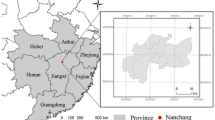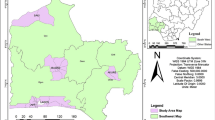Abstract
The characteristics of land use/land cover (LULC) types may affect the thermal environment of urban zones. In this study, the urban zones of the Pearl River Delta (PRD) were examined to explore the spatiotemporal variations in land surface temperature (LST) from 2001 to 2017, as well as the relationships between LST and various influencing factors. Landscape pattern analysis was undertaken to explore the correlation between patch metrics and LST with resolutions from 100 m to 1 km. The results showed that (1) the high-temperature zones were mainly distributed on built-up land; the area of LST hot spots increased from 16% (2001) to 23% (2017). (2) The mean LST of each LULC type was calculated, indicating that the temperature of forestland was more than 5 °C lower than that of built-up land. (3) The landscape patterns of different land use types exhibited various effects on LST in terms of magnitude and importance. Considering the significance of the landscape indexes, it is necessary to avoid a large-scale layout of a single built-up land type when planning an urban environment. It is thus recommended that multiple contiguous forestlands be planned to mitigate urban heat island (UHI) effects. Furthermore, the landscape patterns and structure of different LULC types have various effects on LST and need to be explored in fine detail. This study helped reveal the impact of different LULC types on LST and provides urban planners in the PRD with optional schemes for mitigating the impacts of urbanization on the UHI.









Similar content being viewed by others
References
Amiri R, Weng Q, Alimohammadi A, Alavipanah SK (2009) Spatial–temporal dynamics of land surface temperature in relation to fractional vegetation cover and land use/cover in the Tabriz urban area, Iran. Remote Sens Environ 113(12):2606–2617. https://doi.org/10.1016/j.rse.2009.07.021
Byrne GF, Begg JE, Fleming PM, Dunin FX (1979) Remotely sensed land cover temperature and soil water status—a brief review. Remote Sens Environ 8(4):291–305. https://doi.org/10.1016/0034-4257(79)90029-4
Chen X, Zhao P, Hu Y, Ouyang L, Zhu L, Ni G (2019) Canopy transpiration and its cooling effect of three urban tree species in a subtropical city- Guangzhou, China. Urban For Urban Green 43:126368. https://doi.org/10.1016/j.ufug.2019.126368
Doick KJ, Peace A, Hutchings TR (2014) The role of one large greenspace in mitigating London's nocturnal urban heat island. Sci Total Environ 493:662–671. https://doi.org/10.1016/j.scitotenv.2014.06.048
Ermida SL, DaCamara CC, Trigo IF, Pires AC, Ghent D, Remedios J (2017) Modelling directional effects on remotely sensed land surface temperature. Remote Sens Environ 190:56–69. https://doi.org/10.1016/j.rse.2016.12.008
Falahatkar S, Hosseini SM, Soffianian AR (2011) The relationship between land cover changes and spatial-temporal dynamics of land surface temperature. Indian J Sci Technol 4:76–81. https://doi.org/10.17485/ijst/2011/v4i2/29937
Getis A, Ord JK (1992) The analysis of spatial association by use of distance statistics. Geogr Anal 24(3):189–206. https://doi.org/10.1111/j.1538-4632.1992.tb00261.x
Guo L, Liu R, Men C, Wang Q, Miao Y, Zhang Y (2019) Quantifying and simulating landscape composition and pattern impacts on land surface temperature: a decadal study of the rapidly urbanizing city of Beijing, China. Sci Total Environ 654:430–440. https://doi.org/10.1016/j.scitotenv.2018.11.108
Hu M, Xia B (2019) A significant increase in the normalized difference vegetation index during the rapid economic development in the Pearl River Delta of China. Land Degrad Dev 30(4):359–370. https://doi.org/10.1002/ldr.3221
Jiang Y, Fu P, Weng Q (2015) Assessing the impacts of urbanization-associated land use/cover change on land surface temperature and surface moisture: a case study in the midwestern United States. Remote Sens 7(4):4880–4898. https://doi.org/10.3390/rs70404880
Jimenez-Munoz JC, Sobrino JA (2010) A single-channel algorithm for land-surface temperature retrieval from ASTER data. IEEE Geosci Remote Sens Lett 7(1):176–179. https://doi.org/10.1109/LGRS.2009.2029534
Jiménezmuñoz JC, Cristóbal J, Sobrino JA, Soria G, Ninyerola M, Pons X (2008) Revision of the single-channel algorithm for land surface temperature retrieval from Landsat thermal-infrared data. IEEE Trans Geosci Remote Sens 47(1):339–349. https://doi.org/10.1109/TGRS.2008.2007125
Karnieli A, Agam N, Pinker RT, Anderson M, Imhoff ML, Gutman GG, Panov N, Goldberg A (2010) Use of NDVI and land surface temperature for drought assessment: merits and limitations. J Clim 23(3):618–633. https://doi.org/10.1175/2009JCLI2900.1
Lazzarini M, Marpu PR, Ghedira H (2013) Temperature-land cover interactions: the inversion of urban heat island phenomenon in desert city areas. Remote Sens Environ 130:136–152. https://doi.org/10.1016/j.rse.2012.11.007
Li W, Cao Q, Lang K, Wu J (2017) Linking potential heat source and sink to urban heat island: heterogeneous effects of landscape pattern on land surface temperature. Sci Total Environ 586:457–465. https://doi.org/10.1016/j.scitotenv.2017.01.191
Lin BS, Lin CT (2016) Preliminary study of the influence of the spatial arrangement of urban parks on local temperature reduction. Urban For Urban Green 20:348–357. https://doi.org/10.1016/j.ufug.2016.10.003
Liu Y, Peng J, Wang Y (2018) Efficiency of landscape metrics characterizing urban land surface temperature. Landsc Urban Plan 180:36–53. https://doi.org/10.1016/j.landurbplan.2018.08.006
Mao K, Qin Z, Shi J, Gong P (2005) A practical split-window algorithm for retrieving land-surface temperature from MODIS data. Int J Remote Sens 26(15):3181–3204. https://doi.org/10.1080/01431160500044713
Meng Q, Zhang L, Sun Z, Meng F, Wang L, Sun Y (2018) Characterizing spatial and temporal trends of surface urban heat island effect in an urban main built-up area: a 12-year case study in Beijing, China. Remote Sens Environ 204:826–837. https://doi.org/10.1016/j.rse.2017.09.019
Mohajerani A, Bakaric J, Jeffrey-Bailey T (2017) The urban heat island effect, its causes, and mitigation, with reference to the thermal properties of asphalt concrete. J Environ Manag 197:522–538. https://doi.org/10.1016/j.jenvman.2017.03.095
Morabito M, Crisci A, Messeri A, Orlandini S, Raschi A, Maracchi G, Munafò M (2016) The impact of built-up surfaces on land surface temperatures in Italian urban areas. Sci Total Environ 551-552:317–326. https://doi.org/10.1016/j.scitotenv.2016.02.029
Morakinyo TE, Lau KKL, Ren C, Ng E (2018) Performance of Hong Kong’s common trees species for outdoor temperature regulation, thermal comfort and energy saving. Build Environ 137:157–170. https://doi.org/10.1016/j.buildenv.2018.04.012
Ord JK, Getis A (1995) Local spatial autocorrelation statistics: distributional issues and an application. Geogr Anal 27(4):286–306. https://doi.org/10.1111/j.1538-4632.1995.tb00912.x
Peng J, Jia J, Liu Y, Li H, Wu J (2018) Seasonal contrast of the dominant factors for spatial distribution of land surface temperature in urban areas. Remote Sens Environ 215:255–267. https://doi.org/10.1016/j.rse.2018.06.010
Price JC (1984) Land surface temperature measurements from the split window channels of the NOAA 7 Advanced Very High Resolution Radiometer. J Geophys Res-Atmos 89(D5):7231–7237. https://doi.org/10.1029/jd089id05p07231
Sobrino JA, Li ZL, Stoll MP, Becker F (1996) Multi-channel and multi-angle algorithms for estimating sea and land surface temperature with ATSR data. Int J Remote Sens 17(11):2089–2114. https://doi.org/10.1080/01431169608948760
Sobrino JA, Raissouni N, Li ZL (2001) A comparative study of land surface emissivity retrieval from NOAA data. Remote Sens Environ 75(2):256–266. https://doi.org/10.1016/S0034-4257(00)00171-1
Sobrino JA, Jimenez-Munoz JC, Paolini L (2004) Land surface temperature retrieval from LANDSAT TM 5. Remote Sens Environ 90(4):434–440. https://doi.org/10.1016/j.rse.2004.02.003
Turner DP, Cohen WB, Kennedy RE, Fassnacht KS, Briggs JM (1999) Relationships between leaf area index and Landsat TM spectral vegetation indices across three temperate zone sites. Remote Sens Environ 70(1):52–68. https://doi.org/10.1016/S0034-4257(99)00057-7
Wang K, Dickinson RE (2013) Contribution of solar radiation to decadal temperature variability over land. Proc Natl Acad Sci U S A 110(37):14877–14882. https://doi.org/10.1073/pnas.1311433110
Wang Y, Berardi U, Akbari H (2016) Comparing the effects of urban heat island mitigation strategies for Toronto, Canada. Energy Build 114:2–19. https://doi.org/10.1016/j.enbuild.2015.06.046
Wang S, Ma Q, Ding H, Liang H (2018) Detection of urban expansion and land surface temperature change using multi-temporal landsat images. Resour Conserv Recycl 128:526–534. https://doi.org/10.1016/j.resconrec.2016.05.011
Weber N, Haase D, Franck U (2014) Zooming into temperature conditions in the city of Leipzig: how do urban built and green structures influence earth surface temperatures in the city? Sci Total Environ 496:289–298. https://doi.org/10.1016/j.scitotenv.2014.06.144
Weng Q (2001) A remote sensing?GIS evaluation of urban expansion and its impact on surface temperature in the Zhujiang Delta, China. Int J Remote Sens 22(10):1999–2014. https://doi.org/10.1080/713860788
Weng Q, Lu D, Schubring J (2004) Estimation of land surface temperature–vegetation abundance relationship for urban heat island studies. Remote Sens Environ 89(4):467–483. https://doi.org/10.1016/j.rse.2003.11.005
Xie M, Wang Y, Chang Q, Fu M, Ye M (2013) Assessment of landscape patterns affecting land surface temperature in different biophysical gradients in Shenzhen, China. Urban Ecosyst 16(4):871–886. https://doi.org/10.1007/s11252-013-0325-0
Yang J, Wang ZH, Kaloush KE, Dylla H (2016) Effect of pavement thermal properties on mitigating urban heat islands: a multi-scale modeling case study in Phoenix. Build Environ 108:110–121. https://doi.org/10.1016/j.buildenv.2016.08.021
Yıldız ND, Avdan U, Yılmaz S, Matzarakis A (2018) Thermal map assessment under climate and land use changes; a case study for Uzundere Basin. Environ Sci Pollut Res 25(1):940–951. https://doi.org/10.1007/s11356-017-0424-1
Yin Z, Zheng Y (2015) The analysis for heat island effect changes in Guiyang City base on remote sensing. Int J Environ Monit Anal 2(6):361. https://doi.org/10.11648/j.ijema.20140206.20
Yu X, Guo X, Wu Z (2014) Land surface temperature retrieval from Landsat 8 TIRS—comparison between radiative transfer equation-based method, split window algorithm and single channel method. Remote Sens 6(10):9829–9852. https://doi.org/10.3390/rs6109829
Yuan F, Bauer ME (2007) Comparison of impervious surface area and normalized difference vegetation index as indicators of surface urban heat island effects in Landsat imagery. Remote Sens Environ 106(3):375–386. https://doi.org/10.1016/j.rse.2006.09.003
Yue W, Xu J, Tan W, Xu L (2007) The relationship between land surface temperature and NDVI with remote sensing: application to Shanghai Landsat 7 ETM+ data. Int J Remote Sens 28(15):3205–3226. https://doi.org/10.1080/01431160500306906
Zhang L, Zhan Q, Lan Y (2018) Effects of the tree distribution and species on outdoor environment conditions in a hot summer and cold winter zone: a case study in Wuhan residential quarters. Build Environ 130:27–39. https://doi.org/10.1016/j.buildenv.2017.12.014
Zhao L, Dai A, Dong B (2018) Changes in global vegetation activity and its driving factors during 1982–2013. Agric For Meteorol 249:198–209. https://doi.org/10.1016/j.agrformet.2017.11.013
Zhou W, Wang J, Cadenasso ML (2017) Effects of the spatial configuration of trees on urban heat mitigation: a comparative study. Remote Sens Environ 195:1–12. https://doi.org/10.1016/j.rse.2017.03.043
Funding
This research was financially supported by the National Key R&D Program of China (2016YFC0502803) and supported by the International Program for Ph.D. Candidates Sun Yat-Sen University.
Author information
Authors and Affiliations
Corresponding authors
Additional information
Responsible editor: Philippe Garrigues
Publisher’s note
Springer Nature remains neutral with regard to jurisdictional claims in published maps and institutional affiliations.
Highlights
• LST variations are analyzed with LULC, spectral variables and landscape indexes.
• Built-up lands with high building densities aggravate the UHI.
• Spectral variables exhibited a relatively strong correlation with LST.
• Patch matrices exhibited fluctuating correlation values at different scales.
• It is recommended to arrange multiple contiguous forestland areas to mitigate UHIs.
Rights and permissions
About this article
Cite this article
Hu, M., Wang, Y., Xia, B. et al. Surface temperature variations and their relationships with land cover in the Pearl River Delta. Environ Sci Pollut Res 27, 37614–37625 (2020). https://doi.org/10.1007/s11356-020-09768-z
Received:
Accepted:
Published:
Issue Date:
DOI: https://doi.org/10.1007/s11356-020-09768-z




